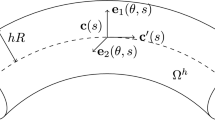Abstract
WE have described earlier1 some of the features which arise when slightly elastic liquids are made to flow under a pressure gradient through curved pipes of circular cross-section. Our remarks were chiefly concerned with the flow characteristics just before and just after the region which marks the transition from laminar to turbulent flow, and with the transition region itself.
Similar content being viewed by others
References
Barnes, H. A., and Walters, K., Nature, 216, 366 (1967).
Dean, W. R., Phil. Mag., 5, 673 (1928).
Jones, D. T., thesis, Univ. Wales (1967).
Adler, M., Z.A.M.M., 14, 125 (1934).
Taylor, G. I., Proc. Roy. Soc., A, 223, 446 (1954).
Author information
Authors and Affiliations
Rights and permissions
About this article
Cite this article
BARNES, H., WALTERS, K. Dynamic Similarity and Drag Reduction in Flow of Elastic Liquids through Curved Pipes. Nature 219, 57–59 (1968). https://doi.org/10.1038/219057a0
Received:
Revised:
Issue Date:
DOI: https://doi.org/10.1038/219057a0
- Springer Nature Limited
This article is cited by
-
A review on drag reduction with special reference to micellar systems
Colloid & Polymer Science (1984)
-
Considerations on fish locomotion
Meccanica (1975)
-
Drag Reduction in Rotational Viscoelastic Boundary Layer Flows
Nature Physical Science (1973)
-
Fluid Dynamics Approach to the Toms Effect
Nature (1969)





